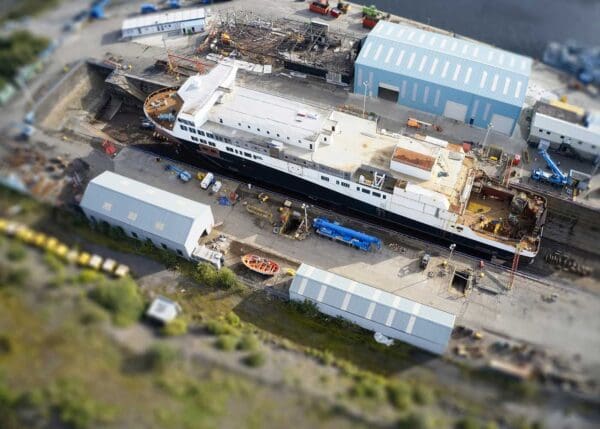01. Shipyard History
History
The former Avondale Shipyard was located in Avondale, Louisiana, along the Mississippi River. The shipyard was in operation from 1938 to 2014. It had many different owners throughout its history, including Litton Industries, Northrop Grumman and Huntington Ingalls Industries.
The shipyard was a private employer that worked on commercial and U.S. Navy contracts, building and repairing ships. Avondale Shipyard started receiving contracts from the U.S. Navy during WWII beginning with a series of tugboats. The shipyard hit its peak employment during WWII with 26,000 workers. After WWII, the shipyard continued building Navy ships, including destroyers and destroyer escorts. It also expanded to offshore oil rigs, drilling barges and fishing boats.
The success of Avondale Shipyard continued through the Korean and Vietnam Wars. In the 1980s, Avondale Shipyard began utilizing modular construction and invested in facility improvements and expansion. The 1990s was a turbulent time for the shipyard with both great losses and immense gains.
It was announced the shipyard would be closed in 2010, and the final ship, the USS Somerset, was completed in 2014. The shipyard was purchased in 2018 by Avondale Marine, a joint venture between Virginia-based T. Parker Host and Illinois-based Hilco Redevelopment Partners.
Avondale Shipyard History at a Glance
- Other Names: Avondale Marine, Avondale Marine Ways, Inc.
- Location: Avondale, Louisiana, along the Mississippi River
- Owner(s): James G. Viavant, Harry Koch and Perry N. Ellis, Ogden Corporation, Litton Industries, Northrop Grumman, Huntington Ingalls Industries and Avondale Marine LLC
- Years of Operation: 1938 – 2014
- Wartime Operations: World War II (WWII), Korean War, Vietnam War and the Cold War
- Number of Employees: 26,000 during WWII
- Size of Shipyard: 254 acres
- Noteworthy Ships: USS Patterson, USS Vreeland, USS Trippe, USS Ouellet, USS Joseph Hewes, USS Bowen, USS Paul, USS Cook, USS Donald B. Beary, USS Kirk, USS Jesse L. Brown, USS Ainsworth, USS Miller, USS Capodanno, USS Valdez
- Types of Ships Built/Serviced: Destroyers, destroyer escorts, amphibious ships, barges, tugboats, oil rigs, drilling barges, fishing boats, cargo ships, tankers, dredges, container vessels, Coast Guard cutters, minesweepers, frigates
Many workers at Avondale Shipyard were potentially exposed to asbestos. Workers’ loved ones may have also experienced secondhand exposure. As a result, many people developed asbestos-related diseases, such as asbestosis, asbestos lung cancer, and pleural and peritoneal mesothelioma. People who developed an asbestos-related disease may be eligible for compensation.
Notable Ships Built and Repaired
Throughout the years, Avondale Shipyard built commercial and U.S. Navy ships. Some of the U.S. Navy ships went on to make their mark on history. Two of these ships include the USS Kirk, which was active in the Vietnam War, and the USS Ouellet, which helped confiscate more than 12 tons of illegal drugs.
USS Kirk
The USS Kirk was a destroyer escort laid down at Avondale Shipyard in 1970. Her most famous mission involved rescuing 200 Cambodian and South Vietnamese refugees after the fall of Saigon in 1975. The ship’s original mission was to shoot down any North Vietnamese jets that might try to stop Marine helicopters.
Instead, USS Kirk ended up assisting 16 South Vietnamese helicopters filled with refugees. With so many helicopters low on fuel and needing to land to unload refugees, the helicopters would be pushed overboard once the people were safely unloaded. Other helicopters, too large to land on the deck of the USS Kirk, dropped passengers while they hovered overhead.
After that mission, the USS Kirk was assigned to help save 20,000 to 30,000 Vietnamese refugees fleeing aboard 30 vessels of the South Vietnamese Navy, dozens of fishing boats and a few cargo ships. For decades after, she went through many overhauls and conducted many missions and exercises. She was decommissioned in 1993 and sold to Taiwan in 1999.
When the USS Kirk was built and active in the Vietnam War, asbestos was used in shipbuilding and repair. Anyone building, working on or aboard the destroyer escort may be at risk of developing mesothelioma.
USS Ouellet
USS Ouellet was a frigate laid down at Avondale Shipyard in 1969. Having had overhauls in 1974 – 1975 and 1978, she had her third overhaul in 1985. This overhaul was to prepare for deployment in 1987 to the Indian Ocean and the Gulf of Oman for the Iran crisis.
In 1988, USS Ouellet participated in a special operation coordinated by the Coast Guard to capture the cargo ship, Christina M., which was carrying more than 12 tons of marijuana. She participated in another law enforcement operation with the Coast Guard in 1990 called “Legal OPS ’90,” in which she recovered close to one ton of pure, unprocessed cocaine. This was the first time that a Coast Guard flag flew from a U.S. Navy warship in this type of operation. The USS Ouellet was decommissioned in 1993.
During the construction and overhauls of USS Ouellet, asbestos was used in ship building materials. It is likely that anyone working on this ship from the time she was built to the time she was decommissioned was exposed to asbestos, putting them at risk of asbestos-related diseases.
Resources for Mesothelioma Patients
02. Shipyard Asbestos Use
Asbestos Use at Avondale Shipyard
Asbestos has properties ideal for building ships. It is highly resistant to heat, fire and physical breakdown. Thus, shipbuilders used asbestos to decrease fire and combustion risks associated with heavy, dangerous equipment.
Avondale Shipyard was active from 1938 to 2014. During much of this time, asbestos use was very common. At Avondale Shipyard, asbestos was used as insulation in walls, boilers, incinerators and around pipes. As a result, workers came in contact with many products that put them at risk of asbestos-related diseases.
Asbestos Exposure at Avondale Shipyard
Civilian workers and military service members worked in shipyards and aboard ships. From the 1930s to the 1980s, tons of asbestos were used in shipyards and shipbuilding. As a result, U.S. Navy veterans and civilian workers at Avondale Shipyard faced a high risk of asbestos exposure and developing malignant mesothelioma cancer.
Those who helped maintain or repair destroyers, destroyer escorts, frigates and other types of ships also faced these risks. The heavy use of the dangerous mineral, along with poor ventilation on ships, led to frequent asbestos exposure. For example, insulators were exposed through installation and maintenance work.
Although asbestos use ceased at shipyards by the 1980s, workers and visitors may still risk exposure today. Asbestos materials may still be found on ships built before the 1980s and older equipment at shipyards. Working with asbestos insulation, repairing old boilers and other shipyard duties put individuals at risk of exposure.
03. Asbestos Lawsuits
Asbestos Lawsuits and Settlements
Anyone who was onsite at Avondale Shipyard and came in contact with asbestos products is at risk of developing asbestos diseases such as mesothelioma and asbestos cancer. These individuals have many options for compensation.
Asbestos product manufacturers are responsible for exposing people to asbestos. The legal status of these companies can affect what compensation is available to victims. Mesothelioma lawyers can help victims determine if a lawsuit, settlement, VA claim and/or trust fund claim (or a combination of these) is the best compensation option.
Holding Asbestos Companies Responsible
Some asbestos product manufacturers remain in business today. This means these companies have not filed for bankruptcy and victims can file lawsuits against the company. Lawsuits may result in compensation through verdicts or settlements.
For example, people were wrongfully exposed to asbestos at Avondale Shipyard because of products supplied from Aqua-Chem. Aqua-Chem has provided supplies to the military since WWII and some of their boilers included gaskets that contained asbestos.
Likewise, Nash Engineering, Co. provided pumps for Navy ships that were used in the boiler rooms. These pumps contained asbestos, putting any workers or crew members with access to these pumps at risk of developing mesothelioma.
Victims have filed successful lawsuits against these companies.
04. Filing Asbestos Claims
Asbestos Company Trusts
Some companies who wrongfully exposed people to asbestos turned to bankruptcy to handle asbestos-related claims. Since the 2000s, more than 100 companies have taken this approach. Many of these asbestos companies created trust funds in order to compensate victims of asbestos-related diseases.
Shipyard workers developed asbestos-related diseases after working with asbestos products. One compensation option for these individuals is to file a claim with that asbestos company’s trust.
Asbestos Company Trust Funds and Eligible Years of Employment
The following companies provided asbestos products to Avondale Shipyard. After facing many asbestos lawsuits and exposing innocent people to asbestos, these companies filed for bankruptcy and created trusts to pay victims. If an individual worked at Avondale Shipyard and developed a disease such as mesothelioma, they may be able to file a claim against these companies’ trusts.
| Asbestos Trust Funds & Eligible Years of Employment | ||
|---|---|---|
| Asbestos Company Name | Eligibility Start Date | Eligibility End Date |
| Armstrong WI Trust | 1/1/1962 | 12/31/1982 |
| Babcock & Wilcox | 1/1/1940 | 12/31/1982 |
| Combustion Engineering | 1/1/1964 | 12/31/1982 |
| Fibreboard | 1/1/1939 | 12/31/1982 |
| Flintkote | 1/1/1956 | 12/31/1982 |
| Flexitallic | 6/20/1966 | 12/31/1982 |
| Halliburton | 6/1/1974 | 2/28/1975 |
| Keene Corporation | 1/1/1939 | 12/31/1982 |
| NARCO | 1/1/1963 | 3/31/1965 |
| Owens Corning | 5/24/1969 | 12/31/1982 |
| Pittsburgh Corning | 7/1/1962 | 12/31/1982 |
| Turner & Newall | 1/1/1961 | 12/31/1982 |
| United States Gypsum | 1/1/1962 | 1/2/1968 |
05. Shipyard News
Avondale Shipyard News
A former employee of ten years at Avondale Shipyard sued Avondale Shipyard for damages from asbestos exposure, which has led to silicosis disease. His diagnosis puts him at a greater risk for developing mesothelioma cancer.







